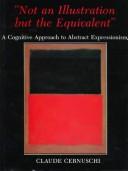Check nearby libraries
Buy this book

The author of this well-illustrated study uses the heuristic models developed by contemporary cognitive scientists for describing human perception and cognition to articulate a new interpretive framework and critical terminology to address the interpretation of New York School abstraction. Although art history, as it stands now, offers few methodological avenues to address such issues persuasively, recent cognitive psychology provides the possibility of treading new interpretive ground.
This book, therefore, is an attempt to bring the latest findings of cognitive psychology to bear on the interpretation of Abstract Expressionism.
Though frequently articulate about their intentions, Abstract Expressionist artists have frustrated interpretive ventures by deliberately avoiding clear explanations of their individual works. By insisting that their works were abstract yet simultaneously capable of disseminating meaning to a wider audience, the artists ran afoul of accepted notions of abstract art and raised a number of key issues that have bedeviled scholarship ever since the movement began.
If the majority of critics saw abstraction in purely formal terms, the artists themselves insisted that the function of their works was the construction and communication of meaning. However, the artists never clarified the nature of this meaning nor the ways in which meaning could be specifically communicated by means of an abstract idiom. Conceptual tools emerging from recent cognitive science, however, permit the investigator not only to put the spectator's experience at the center of interpretive ventures, but they also allow a redefinition of abstraction's ability to disseminate meaning in accordance with the claims made by the Abstract Expressionists about their own works.
The object is to answer questions such as: Under what kind of critical assumptions is meaning compatible with an abstract pictorial idiom? How did the artists of the New York School engage in the construction of meaning? What kinds of meanings did these artists themselves associate with the formal configuration of their canvases? And how are such meanings communicated to the spectator?
In the same way that linguistic expressions frequently use the physical as a metaphor for the psychological, the argument is made that the artists of the New York School intentionally, albeit intuitively, engaged similar strategies of metaphorical projection to construct the meaning of their own abstractions.
The author argues that the formal configurations of many Abstract Expressionist paintings conform to the very same image schemata that cognitive psychologists see as central to human perception and cognition, and that these schemata, in turn, although susceptible to multiple readings depending on one's culture of origin, will nonetheless constrain interpretation to such an extent as to provide a common interpretive denominator between artist and audience.
Check nearby libraries
Buy this book

Previews available in: English
Showing 1 featured edition. View all 1 editions?
| Edition | Availability |
|---|---|
|
1
"Not an illustration but the equivalent": a cognitive approach to abstract expressionism
1997, Fairleigh Dickinson University Press, Associated University Presses
in English
0838637108 9780838637104
|
aaaa
Libraries near you:
WorldCat
|
Book Details
Edition Notes
Includes bibliographical references (p. 159-167) and index.
Classifications
The Physical Object
ID Numbers
Community Reviews (0)
Feedback?| July 12, 2024 | Edited by MARC Bot | import existing book |
| October 17, 2022 | Edited by ImportBot | import existing book |
| February 28, 2020 | Edited by MARC Bot | remove fake subjects |
| July 14, 2017 | Edited by Mek | adding subject: Internet Archive Wishlist |
| December 10, 2009 | Created by WorkBot | add works page |









